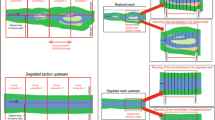Abstract
Aquatic habitat change caused by flooding was quantified along the Fiume Tagliamento, a morphologically intact gravel-bed river ecosystem in northeast Italy. Five different geomorphic reaches (each around 1.5 km), ranging from near the headwaters at 800 m above sea level (a.s.l.) to near the mouth at 5 m a.s.l., were studied over a 1-year period. All floodplain water bodies in each reach were delineated in August 1999 using a differential global positioning system. Each reach was remapped twice (in December 1999 and August 2000) to investigate the impact of autumn and spring flood seasons on aquatic habitat composition and configuration. A high degree (nearly 62%) of aquatic habitat turnover was documented in a braided headwater floodplain. The degree of aquatic habitat turnover decreased with decreasing elevation to approximately 20% turnover in a meandering reach at 5 m a.s.l. In contrast to turnover, braiding, sinuosity, and aquatic habitat composition changed little in response to flooding in all reaches. Location of aquatic habitats in floodplains changed considerably (turnover), whereas habitat configuration and composition remained relatively stable. These results support the applicability of the shifting mosaic steady-state model to riverine floodplain environments.
Similar content being viewed by others
Author information
Authors and Affiliations
Rights and permissions
About this article
Cite this article
Arscott, D., Tockner, K., van der Nat, D. et al. Aquatic Habitat Dynamics along a Braided Alpine River Ecosystem (Tagliamento River, Northeast Italy). Ecosystems 5, 0802–0814 (2002). https://doi.org/10.1007/s10021-002-0192-7
Issue Date:
DOI: https://doi.org/10.1007/s10021-002-0192-7




